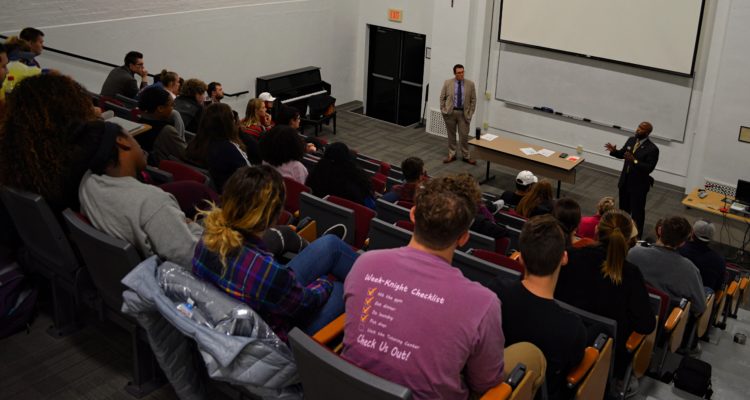By Layla Kellogg
Nearly 50 pre-med students of numerous fields of study came together to hear about one shared interest that affects every single medical student today: diversity.
Students gathered in Pasteur Hall on Nov. 9 to hear doctors from the University of Louisville Medical School speak about the need for medical professionals to be culturally competent and aware of issues regarding diversity.
The event was held by Multicultural Association of Pre-Health Students (MAPS), a new RSO that joined Bellarmine’s campus this year.
Guest speakers were Dr. Dwayne Compton, associate dean of the U of L School of Medicine and Dr. Dave McIntosh, associate dean for urban health innovation and chief diversity officer for the School of Medicine. Both are active in diversity work and community engagement and mentor undergraduate students interested in medical school.
They explained that when defining diversity in terms of medical fields, the term includes individuals who are African American, Latino and Latina, women and students from rural areas.
Compton said that these fields need to become more diverse because our country has become more diverse.
“The patient population is a lot more diverse now in 2017,” Compton said. “Our healthcare professionals look nothing like the people they’re serving.”
He stressed the importance of doctors understanding who their patients are with an example on a local scale.
Compton said that there is a 10-to 12-year difference in life expectancy between the East and West Ends of Louisville.
He attributes this to a high number of uninsured people and more food deserts in these areas, which occur when a neighborhood or area of a city has less access to fresh, healthy or organic food. This can be due to physical location or because of a frequent rise in price in some neighborhoods.
Compton urged students to take notice of the ways in which individuals in minority groups may not have the same advantage others have.
“The system was not built for those groups that we see being underrepresented,” Compton said.
One example of this is the cost of the MCAT (Medical College Admission Test), which costs over $300 to take, with additional costs and fees should the student need to retake the test.
Roxana Gonzalez, the MAPS public relations chair, said this can be a huge disadvantage, especially for minorities.
“For many people, this is there one shot at getting in because it’s highly expensive,” Gonzalez said. “Many minorities suffer because they can’t [retake the test]. Majority of the time they can’t do that. They can’t even raise up the money just to take the MCAT once.”
McIntosh explained how the ethnicity or race associated with a name may also hinder success of minority students applying to medical school.
When applications for medical school or for jobs in the medical field are reviewed “black sounding” names get fewer call backs than “white sounding” names, McIntosh said.
McIntosh said there is a steady 40-year decline in black males applying to medical school, where the acceptance rate is 7 percent lower than it is for white individuals.
Janet Mustafic, MAPS vice president, said that a resolution to the lack of diversity in health fields won’t come easily but discussing it is important.
“People need to be more aware of it,” Mustafic said. “Once you make people aware of it, then they can start fixing the problems and trying to resolve the issues.”
The MAPS chapter on Bellarmine’s campus is one way to create solutions and foster success for students.
MAPS’ mission is the organization strives to “establish a network for students interested in pursuing a career in health” and “promote diversity in our community and professional environments.”
“These programs like MAPS are designed to fill the gap that currently exists,” Compton said.
He describes MAPS as a “key program” that can help students get into medical school if they use it wisely.
Compton advises pre-med students to build a network of people in their prospective fields for opportunities in job shadowing and getting experience necessary to set an application apart from peers.
The hour-long discussion concluded with a question-and-answer session for students to ask Compton and McIntosh about applying to medical school, myths and rumors about the application process, the best ways to get accepted, preferred majors and minors of those accepted, necessary prerequisites, the importance of GPA and more.
Both speakers said that although there are disadvantages for some, success is still an option for all.
“If you want it bad enough,” McIntosh said. “There is a path for everyone to get to medical school.”

